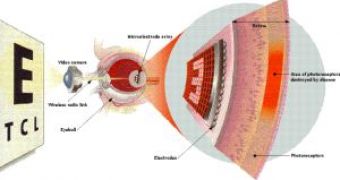A breakthrough in creating robocops has been achieved: the world's first direct electrical link between nerve cells and photovoltaic nanoparticle films.
The achievement made by a team at the University of Texas Medical Branch at Galveston (UTMB) and the University of Michigan is the first step towards an artificial retina, opening the door to exploiting unique properties of nanoparticles to a large array of light-stimulated nerve-signaling devices.
Nanoparticles are artificially made matter bits not too much larger than individual atoms.
Their behavior is determined by molecular forces and quantum mechanics.
These traits make nanoparticles consistent with living cells and physiological activities, like turning light into tiny electrical currents that can inflict responses in nerves. Michigan's chemical engineering professor Nicholas Kotov developed the technology by building a layer-by-layer sandwich of two kinds of ultra-thin films over a glass plate, one made of mercury-tellurium nanoparticles and another of a positively charged polymer named PDDA.
The last layers, one of ordinary clay and one of amino acids (that made them cell-friendly) were in contact with cultured neurons. Exposed to light, the mercury-tellurium nanoparticle film layers produce electric signal electrons, which pass to the PDDA film layers and induce an upward-moving electrical current. "As you build up the layers of this, you get better capabilities to absorb photons and generate voltage," said lead researcher UTMB research scientist Todd Pappas. "When the current reaches the neuron membrane, it depolarizes the cell to the point where it fires, and you get a signal in the nerve."
The nanoparticles are much more efficient and versatile than silicon, which can turn light into electricity, as it is used in solar cells and in the imaging sensors of video cameras. "It should be possible for us to tune the electrical characteristics of these nanoparticle films to get properties like color sensitivity and differential stimulation, the sort of things you want if you're trying to make an artificial retina, which is one of the ultimate goals of this project," Pappas said. "You can't do that with silicon. Plus, silicon is a bulk material - silicon devices are much less size-compatible with cells."
There are also other less complex applications, such as new ways to connect with artificial limbs and other prostheses, and revolutionary new tools for imaging, diagnosis and therapy. "The beauty of this achievement is that these materials can be remotely activated without having to use wires to connect them. All you have to do is deliver light to the material," said co-researcher Professor Massoud Motamedi, director of UTMB's Center for Biomedical Engineering.
"This type of technology has the ability to provide non-invasive connections between the human nervous system and prostheses and instruments that are unprecedented in their flexibility, compactness and reliability," Motamedi continued. "I feel that such nanotools are going to give the fields of medicine and biology brand-new capabilities that it's hard to even imagine now."

 14 DAY TRIAL //
14 DAY TRIAL //